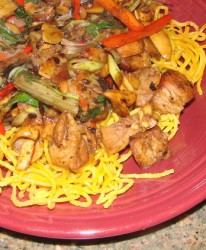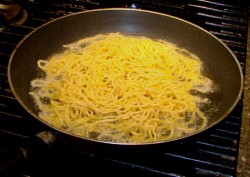Two-Sides-Brown: Pan-Fried Noodle Pancake
This recipe is not often found on the typical American Chinese restaurants, and that is a shame, because it is a delicious dish, filled with textural and flavor contrasts.
I used to eat it at the Chinese restaurant where I worked, and I loved watching the chefs cook the pancakes; they used a large wok and a great deal of oil to turn boiled, drained fresh egg noodles into a round or oval nest of loops and whorls, crispy on the outside and chewy-velvety on the inside.
One chef told me that he grew up calling the noodle pancakes “two-sides-brown,” a poetic name describing how the noodles look after being cooked. His grandmother made them for special dinners, he said, and she made her toppings only of seafood.
Yes, once these noodles are fried into cake-like rounds or ovals, they can be kept warm in an oven. Then, a topping of meat, seafood, tofu, or vegetables with a lot of sauce is prepared in a wok. The noodles are then placed on a serving platter and the topping is poured over it to be served immediately.
The noodles can be cut into wedges before pouring the topping over them or, they can be pulled apart with chopsticks by the diners. I think that cutting them is easiest–after cutting, you can reassemble the cakes, and then pour the topping over it to cover where it has been cut. Then, diners can nab portions with a serving spoon or chopsticks and place them in their own individual bowls or plates.
This is an easy, yet complex-looking dish to prepare; making the pancake is not that hard, especially if you use steamed noodles to make it. With thin steamed noodles, you do not have to further cook them before frying the cake; otherwise, the recipe can be made with boiled fresh egg noodles which have been rinsed in cold water, thoroughly drained and then tossed with one tablespoon each soy sauce and sesame oil to flavor them and to keep them from sticking. Thick steamed noodles should also be pre-boiled as well to soften them completely.
The steaming and/or boiling can be done hours ahead of time. Just cook, rinse, and toss with the soy sauce and sesame oil, then seal in a plastic bag and refrigerate them until needed.
One the pancakes are cooked, they can be held in a 150-200 degree F. oven for an hour if needed. That way, they can be pulled out, and a fresh topping can be poured directly from the wok onto the warm noodles, and the dish can be rushed to the table while the scent of the wok drifts from the steaming platter to the quivering nostrils of the diners. The dish looks impressive and tastes wonderful–and that is all that is needed to make a memorable dinner.
There are mistakes to be made, of course. The first time I made a noodle pancake, I used thicker steamed noodles and neglected to pre-boil them. They turned out too crisp and hard. I also used too few noodles to make too wide of a pancake, so it wasn’t thick enough to have the proper yielding texture in the middle. I corrected these problems with my second batch, however, now I am pleased to be able to make a favorite dish which I seldom see on Chinese restaurant menus.
And a word about the topping. I am giving no topping recipe, because you can use any stir-fry recipe to make a topping so long as plenty of sauce is involved. The sauce soaks into the noodles a bit, softening the crispy crust of them and flavoring the silky, chewy inner parts. Instead of giving you one recipe for a topping, at the end of the recipe, I will give links to stir-fried dishes I have already presented which would make great toppings for your very own noodle pancake dish. (The pork lo mein recipe I am giving is to be used sans the noodles given for the lo mein. Obviously, one would not top noodles with more noodles.)
One more caveat–this is an oily dish by nature. As such, I think it is important to pair it with less rich fare, such as steamed vegetables or clear soups so as to not overburden the stomach with a lot of heavy foods in the same meal. One could also drink pu er tea with the meal–the earthy, slightly bitter quality of the tea is very good for cutting through rich flavors and cleansing the palate. It also acts as a stimulant to aid digestion.
Pan-Fried Noodle Pancake
Ingredients:
1 pound steamed or plain fresh Chinese egg noodles
1 tablespoon sesame oil
1 tablespoon light soy sauce
4 tablespoons canola or peanut oil
Method:
If the steamed noodles are very fine and thin, you can just go ahead and fry them. The way to go about this is to put two tablespoons of oil in a wide, heavy-bottomed nonstick skillet over medium heat. When it is hot, gently lower the steamed noodles into the oil, spreading them out with your fingers (be deft and careful here!) a pair of chopsticks or a set of tongs, into a round disk-like shape, flattening it into a pancake. Sprinkle 1/4 cup of water over the noodles, and then cover the pan and cook for about five minutes. Then, turn the pancake over, add the other two tablespoons of peanut or canola oil and cook on the second side for another five minutes, or until it is brown.
Now–I will say that this is a splattery, messy way to go about making the noodle pancake–it spatters like mad when you sprinkle the 1/4 cup of water over it.
So, I suggest that you just boil your steamed or unsteamed noodles as directed here until they are just a tiny bit softer than al dente. Then drain and rinse them thoroughly in cold water, and drain them thoroughly again. Toss them with the sesame oil and light soy sauce, and then either start making the pancake immediately, or place the prepared noodles into a plastic bag in the fridge to wait until you are ready.
When you are ready, heat two tablespoons of the oil in a wide, heavy-bottomed nonstick frying pan. When it is hot, carefully lay the noodles into the pan, shaping them into a pancake with fingers, chopsticks or tongs. Press them down with a spatula to compact them slightly and get them to stick together. They will still sputter a bit, but not as badly as they would if you sprinkled them with water as in the first method. Cook until browned on the bottom, about five minutes.
To turn it over, I use a spatula in my off hand (left hand) and tongs in my right. I pick up one edge of the pancake with the tongs, sliding the spatula under, and with the courage of my convictions (as Saint Julia would say) and a prayer to the Kitchen God, I carefully flip it over. You can do it this way, you can try tossing it in the pan, or you can slide it out onto a plate, then invert the plate over the pan. Whatever works is fine for me.
After it is turned over, add the rest of the peanut or canola oil and cook that side, pressing down with a spatula a couple of times, until it is browned–about five more minutes.
Remove from the pan and drain on paper towels. Set on a serving platter, and if you wish, cut into wedges, then reassemble them on the platter, and put into a 150-200 degree F oven to hold until serving time.
Here are some stir fried dishes that would be good as toppings; whatever stir fry recipe you use, either make certain it is one that makes lots of sauce, or add more saucy stuff to make plenty of juicy goodness to soak into the noodle pancake.
Stir Fried Dry Tofu with Pork
Morganna’s Simple Vegetable Stir Fry
Chicken with Gai Lan and Oyster Sauce
Beef With Mango
Peng’s Homestyle Beancurd
9 Comments
RSS feed for comments on this post.
Sorry, the comment form is closed at this time.
Powered by WordPress. Graphics by Zak Kramer.
Design update by Daniel Trout.
Entries and comments feeds.





[…] Tigers & Strawberries » Two-Sides-Brown: Pan-Fried Noodle Pancake – Mm, fried noodles. Could be a nice thing to do with the wok we picked up at a yard sale not too long ago. […]
Pingback by Sculpin » My del.icio.us bookmarks for August 18th through August 22nd — August 22, 2007 #
Looks very interesting Barbara 🙂
Comment by Raaga — August 23, 2007 #
What a fun recipe! I especially appreciate the links to appropriate toppings! Without those I’d be lost as to what to try first. 🙂
Comment by Jim — August 23, 2007 #
I learned my recipe from Barbara Troop’s huge book on Chinese cooking and used to get them when she had her restaurant here in SF. I love them but since I’m trying to cut down on the carbs, don’t make them that often. But they are delicious and I always make dipping sauces of vinegar and hot chili oil. I never met a noodle or chili that I didn’t like.
Comment by Nancy — August 24, 2007 #
Barbara, what a great recipe. I am a very big fan of noodles and just as i read your post i started thinking about possible fillings.
Comment by valentina — August 24, 2007 #
I actually have a recipe for spaghetti fritter (I know, odd, eh?). But I have never seen a recipe for anything quite like this one. Intriguing. I must give it a try.
Cheers!
Comment by almost vegetarian — August 27, 2007 #
[…] It’s no secret that Tigers & Strawberries is one of my absolute favorite blogs of all time. So it should come as no surprise that I want you to check out a lot of Barbara’s entries. She invented spicy, floral, tingly, sugary cookies called Frostflowers. I can think of so many saucy dishes that would be wonderful served atop her Two-Sides-Brown: Pan-Fried Noodle Pancake. Although the recipe did not actually originate from Singapore, I keep meaning to try her Singapore Rice Noodles. And who can say no to a tasty plate of Beef Chow Fun? […]
Pingback by Habeas Brulee » Blog Archive » Roundup of Food Blog Posts I’ve Enjoyed #11 — September 21, 2007 #
[…] Tuesday – Dave’s almost as excited about a stir-fry (baby bok choy, chicken, carrot) and noodle cake. […]
Pingback by Lola’s Kitchen » Blog Archive » what’s for dinner? — February 3, 2008 #
I am currently down with what’s known around my college as ‘The Plague’ and what’s better than re-reading your blog as I fight gastro?
Growing up in Hong Kong I’ve had this dish as a dessert with sugar and black vinegar (cheet cho) after a heavy meal. It’s quite possibly one of only sweet and sour dishes I can actually stomach.
Comment by Deb — February 4, 2008 #